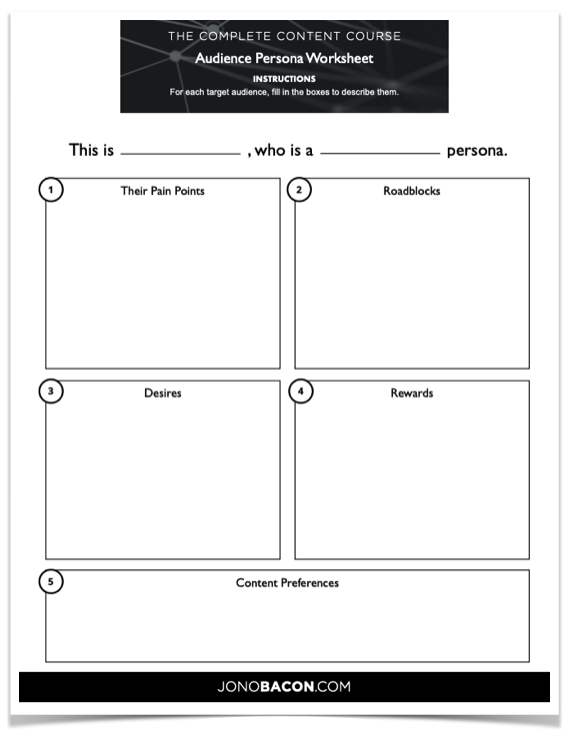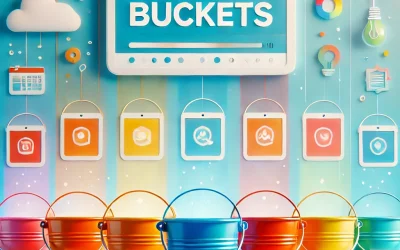Pop quiz! Who is your target audience? It should be an easy question to answer, but how specific can you be? When you’re creating content, do you have a well-defined avatar in mind?
An honest answer for a lot of content creators would be, “Eh…sort of.” Indeed, sometimes we’re just tossing content out there into the world, fingers crossed, and hoping that someone, anyone will read it.
But you wouldn’t walk into a public space filled with random people and just start shouting about—oh, let’s say “email marketing.” Why not? Because in a crowd of random people, chances are most of them won’t have any interest in email marketing, and the few who do probably won’t pay attention because of all the noise around them. You would almost certainly be wasting your breath. Heck, if it’s a global audience, you might not even be speaking their language.
Yet this is what many content creators are essentially doing online—throwing content into the wind and hoping someone will notice. If you’re trying to talk to as many people as possible, you actually make it harder for the right people to hear what you have to say. This is one of the biggest reasons why some great content never gains traction.
In reality, if you wanted to talk to an audience about email marketing, you would select an appropriate venue filled with people that you know had a vested interest in the subject, and you would address it in a way that speaks to their specific interests and needs. The same goes for all of your online content.
Defining your target audience should be foundational to content creation. Know exactly who you’re speaking to before you start speaking! That way you’re sure that you are speaking their language, addressing their actual pain points, and providing solutions they want and need.
Starting from the Other End
While many content creators focus on trying to create content that generates interest with their audience, I recommend starting from the other end of the equation. First, get to know your audience, understand their pain, roadblocks, and desires, and then focus on trying to relieve that pain, get them over those roadblocks, and meet those desires.
Consider the following pairs of headlines. Which one speaks more effectively to the specific pains of a relevant audience:
“5 Ways to Build a Better Business” or “5 Business Expenses You Can Cut Right Now”
“How to Create a Great Blog Article” or “Overcome Writer’s Block and Start Creating Awesome Blog Content Today”
“7 Ways to Win Over Investors” or “7 Ways to Make Sure Your Investor Pitch Isn’t Boring”
What’s the difference between the two headlines? The second headline in each pair comes from a place of 1) understanding a specific audience, 2) knowing their needs, 3) speaking to those needs. Of course, to do that, you first have to define your target audience, and that means creating a persona.
People in marketing sometimes waffle when it becomes to creating personas because it seems like too much nitpicky work. Look, we don’t need to know exactly what your target audience puts in their Weetabix for breakfast. We just need to clarify enough information to ensure that we are creating content that is optimized for their needs and interests.
To help you with this, I’ve created an easy-to-use audience persona template. Download it and follow along. I’ll walk you through the template box by box, using my own examples, to make this as painless as possible.
To select a persona, you first need to think of your audience. This is the broad category of people that you need to reach and build relationships with. Do you need to reach small business owners, marketers for fintech companies, C-suite leaders of large corporations, B2B salespeople, independent contractors who work from home (and so on)?
Step One: Identify Your Persona
With your audience in mind, narrow it down to single individuals. These are your personas. They aren’t real people but fictional concepts of who members of your target audience might be.
Maybe your persona is:
- Dave, the 35-year-old founder of a small investment company,
- or Rachel, a 24-year-old B2C marketer,
- or Abdul, the 57-year-old president of a fintech company.
Fill out the top line of the Audience Persona Worksheet: “This is Dave, a small-company founder, who is a buyer persona.”
Once you’ve settled on a persona, you can begin to identify their pain points, roadblocks, desires, rewards, and content preferences. Use your creativity to come up with this information. Remember, it’s a fictional person, but it needs to represent your target audience well.
Step Two: What Are Their Pain Points?
The content that resonates best is the content that makes people’s problems go away. If you figure out your target audience’s pain points, you’re going to open the door to a whole lot of excellent content ideas, because you’ll know the specific issues you need to address to make an impact.
On the worksheet, identify the specific pain points for your persona. What are the things they struggle with? Are there aspects of their job that they hate? What are the things that keep them up at night? Write these down as bullet points in the appropriate box.
Examples of pain points might include:
- Dave, the small-company founder, struggles with recruiting new talent.
- Rachel, the B2C marketer, feels increasingly frustrated trying to use Google AdWords effectively.
- Abdul, president of a fintech company, is stressed out trying to set competitive prices for his products and services.
Step Three: What Are Their Roadblocks?
Roadblocks are the things standing in your persona’s way, hindrances that make it more difficult to achieve their goals.
- For Dave, the small-company founder, a big roadblock to hiring great talent are budget constraints.
- In the case of Rachel, the B2C marketer, constantly tweaking keywords has become a time-consuming roadblock to creating brand recognition.
- For Abdul, the fintech president, customer research seems complex and difficult, but the feedback is absolutely necessary.
Any content that might help your persona overcome these roadblocks will be deeply appreciated. What is standing in their way? Identify specific things that slow them down and hinder them from achieving their goals. Write them down as bullet points in the appropriate box.
Step Four: What Are Their Desires?
When your persona wakes up in the morning, what are they excited about? What is it that really moves and motivates them? Examples of persona desires might include:
- Dave, the small-company founder, absolutely loves finding a new potential hire who is a perfect fit for the company culture.
- For Rachel, the B2C marketer, brand loyalty is what gets her up and moving in the morning. It’s her dream to make customers fall in love with the brand.
- Abdul, the fintech president, gets energized when he thinks about entering new markets.
Any content that can speak to these desires, that can really move your persona, is going to get their attention right away.
Step Five: What Are Their Preferred Rewards?
What are the things your persona likes to be rewarded with? Do they like t-shirts, gadgets, public recognition from their community, or do they prefer things like building new partnerships, winning over new audiences, and entering new markets to build brand recognition?
Some of the content you create can act like a carrot on a stick, enticing readers into a deeper relationship with you by offering rewards that matter to them.
- Dave, the small-company founder, is chiefly interested in networks and communities that will enable him to meet skilled people who might be potential hires.
- For Rachel, the B2C marketer, appreciates any free seminar, webinar, or training session that will improve her marketing skills.
- Abdul, the fintech president, is a gadget guru, so any new tech, app, or device is going to pique his interest.
Identify the desired rewards of your persona and write them in this box.
Step Six: What Are Their Content Preferences?
Finally, you need to determine how your persona prefers to consume content. Do they like to read books and articles? Do they like listening to podcasts, YouTube videos, or webinars? Maybe they prefer to attend seminars and training sessions. Are there specific websites or social media platforms they like better?
Write down the ways your persona likes to consume information. Be thorough, even if you run out of space in the box and have to continue on the back of the page.
- Dave, the small-company founder, is active on various social media channels, especially LinkedIn, Facebook, and Instagram. This is where he connects with people and consumes content.
- For Rachel, the B2C marketer, prefers podcasts, videos, and webinars, which she often consumes while commuting on public transportation.
- Abdul, the fintech president, spends his free time reading short content articles, especially tech-related articles from experts in the field.
Figuring out your persona’s content preferences will help you focus on using the right channels to reach them with your content. For example, if you’re trying to reach Rachel, maybe you need to spend less time on a blog and more time producing short, meaningful YouTube videos.
Get Feedback on Your Personas
Once you’ve filled out all of the boxes for your persona, get a variety of feedback and criticism from team members, friends, and family. Adjust your persona as needed until you’ve got it just right.
With clarity on your personas, you can now adjust your content strategy to serve them. Everything you do needs to have a clear dotted line that connects to your target personas. Otherwise, you run the risk of wasting your time and resources.
All of this will create a focused, personalized content experience that they will love, and that’s the key to long-term meaningful relationships.
image credit: https://blog.hubspot.com/marketing/build-audience-online










